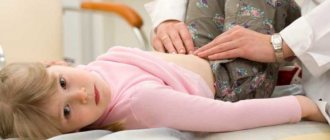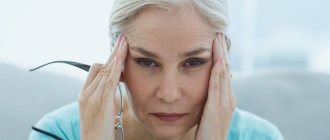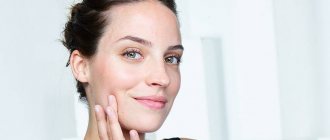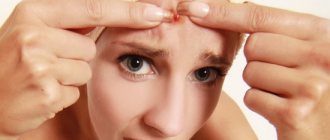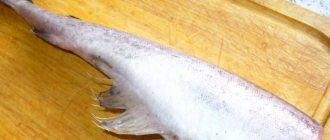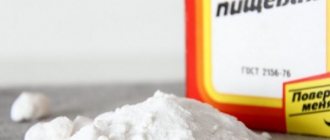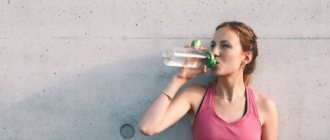What are the types of acne marks?
Those who like to squeeze out pimples and blackheads can be immediately noticed by their characteristic skin defects.
Atrophic scars are small, depressed scars with smooth edges. Most often they appear on the face and come in several types:
- Rectangular . Oblong-shaped recesses, which experts call “freight trailers.” The deeper such scars, the more difficult it is to remove them.
- Chipped . Elongated “cut” oblong paths. Most often they occur on the cheeks and are very difficult to correct, since even with a small size they can have a decent depth.
- Rounded . The pits are round in shape, which can be superficial or deep. If small lesions can be dealt with using light peeling and home remedies, then deep ones have to be removed using laser procedures and deep chemical peeling - exfoliation of the upper layers of the skin.
Hypertrophied scars are raised above the surface. They most often form on the back and chest. They often occur in patients with a tendency to keloid processes - a feature of the body in which any damage is accompanied by extensive growth of connective tissue. As a result, unsightly bumps appear at the site of acne, often having a reddish or bluish tint.
Post-inflammatory erythema is red marks left at the site of acne. They may disappear over time, but without treatment they will persist for 6-12 months or longer.
Post-inflammatory hyperpigmentation is dark spots left behind by acne. They can have different shades from light to dark brown. They intensify after exposure to the sun, so if you are prone to their formation, you should use sunscreen during the hot season.
After severe acne, several types of such marks may appear on the skin at once, especially if you do not consult a cosmetologist in time and take action.
Atrophic scars
Keloid scar
How to remove acne marks at home
There are several recipes for homemade masks that can help fight post-acne. Be sure to check for allergies before use.
Badyagi-based mask
Badyaga is a powder known for its anti-inflammatory properties, effective fight against age spots and post-acne. You can buy it in pharmacies. Easy to use and prepare:
- Mix a teaspoon of powder with a tablespoon of warm water and a tablespoon of cosmetic oil (jojoba, argan, shea, etc.);
- Apply the resulting homogeneous mixture to problem areas. Massage lightly for 5 minutes;
- Rinse off with warm water;
- Blot with a paper napkin.
How to get rid of acne: acid peeling
Boric acid can be purchased in two forms: loose (powder) and liquid. For peeling we need the first option. She actively fights post-acne and acne. How to prepare and use:
- Take 75 milliliters of water and 2 grams of powder, dilute to a homogeneous consistency;
- Apply the resulting mixture to problem areas and hold for 1 to 5 minutes.
Important: if you have inflammation on your skin, refuse the procedure. If your skin is delicate and sensitive, keep the composition to a minimum.
Why do acne marks form?
The development of these skin manifestations is influenced by many factors, one of which is genetic. Some patients are so prone to acne scarring that they develop marks from even mild acne. Often this trait happens in families. This category of patients needs to especially carefully monitor their skin condition.
In other cases, it is impossible to predict whether the patient will have acne marks. Therefore, it is important that all skin manifestations are promptly treated by a dermatologist. Early treatment will help clear up pimples before they damage your skin.
Why facial scars after acne cannot be removed with laser
The advertisement claims that the laser removes scars from the skin without leaving a trace. In the case of receding acne scars, this is fundamentally wrong.
Laser peels and resurfacing are effective only against problems of the papillary dermis. Not a single doctor will undertake to smooth out the skin and grind away acne scars to the level of the mesh layer - this is a 100% guarantee of the appearance of new scars (we remember that the mesh layer is restored only by scarring).
Only subcutaneous microsurgical cutting of scars using the subcision method copes with scars of the mesh layer and smoothes the skin. Maxim Vasiliev’s method is based on subcision, which removes scars of any depth.
Subcision is a painstaking method of correcting atrophic post-acne scars.
Review
“In my youth I suffered greatly from acne, I waited a long time for it to disappear on its own. On the advice of a friend, I squeezed out the pimples - it only got worse. As a result, acne left scars and spots all over the body, even on the butt. What to do?
I turned to Platinental in hopes of laser resurfacing, but I was referred to Dr. Vasiliev Maxim. It turns out that acne scars cannot be solved with laser; for such cases, there is another method - subcision.
I am very pleased with the first results, the scars have already been removed from my face, my skin has become much smoother.”
How to remove acne marks
Inflammatory erythema, the red marks left by acne, is treated with creams and serums containing anti-inflammatory ingredients. Therapeutic masks that soothe the skin have a good effect. It is undesirable to be in the sun without sunscreen, since hyperpigmentation in the form of dark areas may appear in place of the red spots.
Hyperpigmentation - dark marks are removed using whitening masks or creams. If there is no effect, they resort to prescription drugs - hydroquinone, azeleic acid and tazarotene, which improve the appearance of the skin. The laser gives a good effect. Two to three procedures are usually sufficient to significantly lighten age spots.
Atrophic acne scars, which appear as depressions or pits in the skin, usually do not go away without treatment. In this case, carbon dioxide and erbium lasers will help, which stimulate the production of collagen, the protein that fills such traces. The effect of microneedles helps, breaking up scars and stimulating the restoration of skin structures.
Hypertrophic scars also do not disappear over time. To eliminate them, laser and mechanical resurfacing – dermabrasion – is prescribed. Peels help well - procedures during which the top layer of skin along with scars is removed with the help of chemicals. Such treatment can be combined with the prescription of absorbable drugs.
Removing acne marks
Post-acne - symptoms and treatment
Complications of post-acne, as a rule, appear when a person seeks to get rid of stagnant spots and existing scars through trauma and other types of impact on the skin.
Early complications include:
- pronounced swelling;
- secondary infection (pustulization and impetiginization);
- exacerbation of herpes infection;
- allergic dermatitis.
Late complications include:
- persistent erythema;
- post-traumatic hyperpigmentation;
- depigmentation;
- formation of new scars.
Severe swelling is a consequence of a general inflammatory reaction in the skin. It occurs in response to damage and is a protective-adaptive process during which the body restores normal physiological reactions of the skin.
Secondary infection can occur when pathogenic or conditionally pathogenic microflora (most often staphylococci, less often representatives of gram-negative bacteria and extremely rarely anaerobic flora) join the inflammation process. As a result, such infection leads to the secondary appearance of pustules and impetigo (vesicle-purulent rashes).
Factors predisposing to pustulization and impetiginization:
- the number of bacteria that have entered the wound (100 thousand pathogens per 1 g of tissue - approximately this ratio is necessary for the development of the inflammatory process);
- decreased general immunity of the patient;
- the presence of chronic stress and concomitant somatic diseases;
- long-term use of medications, etc.
Erysipelas is the most severe form of secondary infection. The focus of infection usually forms against the background of sensitization (acquisition of sensitivity) of the body to B-hemolytic streptococcus. The pathogen multiplies in the lymphatic capillaries of the papillary and reticular layers of the dermis.
Erysipelas is characterized by serous or serous-hemorrhagic inflammation with signs of general intoxication of the body. It, in turn, can also be complicated by phlegmon (phlegmonous erysipelas) and necrosis.
Along the way, erysipelas occurs:
- primary - exists from several days to 1-2 years after the previous process;
- recurrent - occurs two years after the previous process and is usually characterized by a different localization.
Exacerbation of herpes infection is a common complication that occurs after overly aggressive methods of treating post-acne skin. This is especially important to keep in mind for patients with a history of frequently recurrent herpes: they need to undergo mandatory antiviral preventive therapy before treating post-acne.
An extremely rare but serious complication when herpes viruses are attached is herpetic eczema - acute smallpox-like pustulosis of Juliusberg. In the absence of adequate treatment, even death is possible.[16] This disease is characterized by:
- widespread rashes;
- severe itching;
- febrile (38-39°C) and pyretic (39-41°C) fever;
- enlarged lymph nodes;
- addition of pyococcal infection;
- development of sepsis (in severe cases).
Allergic dermatitis can occur when the skin is exposed mainly to various chemicals (peels) that cause a delayed (IV) hypersensitivity reaction. The allergen has the ability to penetrate intact skin and is usually a low molecular weight rather than a dense compound.
Persistent erythema (redness) may result from CO2 laser resurfacing or erbium laser resurfacing. It remains on the skin for 3-4 months. Histologically, redness occurs as an inflammatory reaction or is a manifestation of the immaturity of the new epithelium. The demarcation line (the line between the laser-treated skin and healthy tissue) may also cause some discomfort to patients, but this is not something to worry about as this will go away over time.
Post-traumatic hyperpigmentation can be observed in patients with dark skin, so the choice of treatment for aesthetic skin disorders always begins with determining its phototype.[17]
| Skin type | Type I | Type II | III type | IV type | V type |
| Color of the skin | light, with freckles | light, with freckles | light | dark | very dark |
| Eye color | blue or green | brown or blue | brown or dark | brown or dark | brown |
| Hair color | light or red | light or red | dark brown or chestnut | dark | dark |
| Tanning pattern | the skin burns easily and severely, often turns red, and a permanent tan rarely appears | light tan, skin turns red | good tan | the tan goes on easily and evenly | the tan goes on easily and evenly |
| Reaction to ultraviolet rays | severe irritation | quite irritating | slight irritation | there is no irritation | there is never irritation |
When to start treating acne scars
Treatment should begin at the stage when the acne begins to disappear - there is no need to wait until the skin is completely clear. In this case, it may be possible to completely avoid the appearance of residual marks. Ideally, you should contact a cosmetologist immediately after acne forms. A specialist will help get rid of acne, preventing it from spreading across the skin.
The ideal option is to prevent acne. In spring and summer, when there is increased sebum production and the skin is exposed to dust and other negative factors, you need to undergo preventive treatment. For this purpose, facial cleansing is carried out, during which conditions are created that prevent the formation of acne.
To get rid of acne and the marks caused by it, you need to contact the Center for Aesthetic Medicine. Specialists will select the most suitable treatment method and improve the appearance of the skin.
Removing acne marks on the face with cosmetics
Post-acne is a serious problem for the skin, and it’s not easy to get rid of it. This means that you don’t need to skimp on skincare products. This is not the case when you can save money. It’s easy to choose a good product if you look at the composition and pay attention to the percentage of acids in cosmetics. For effective treatment you need a whole range of tools:
- For washing - look for salicylic or any other acid in the composition;
- Toning - the higher the percentage of acid, the better;
- Cream containing retinol (but not more than 1%). Its properties are described above;
- Cream with acids (glycolic and others);
- Moisturizing and/or nourishing cream to prevent flaking from all acids and soothe the skin.
Remember that removing acne marks is not easy. This is a long journey that requires a lot of patience, endurance and considerable expenses. If you endure everything, the result will pleasantly surprise you.
How do acne scars and spots form? How to get rid of post-acne?
Changes in the structure of the skin cause a cascade of reactions in the wound process, which occurs in several stages:
- Inflammation. Primary vasoconstriction occurs, followed by vasodilation. At this stage, stimulation of melanogenesis, dispigmentation, and the formation of stagnant spots may occur.
- Formation of granulation tissue. Capillary growth starts. Approximately on the 3-5th day, fibroblasts begin to produce new collagen fibers. At first, type III collagen predominates in the wound and only about 20% type I collagen. As the scar forms, this ratio changes in the opposite direction. There is a proliferation of keratinocytes migrating into the wound.
- Matrix remodeling. This is the longest stage, it lasts from several weeks to months. Keratinocytes, fibroblasts, and sebocytes produce enzymes that are responsible for the architecture of MMPs (extracellular matrix metalloproteinases), as well as their tissue inhibitors. Due to the lytic cascade caused by MMPs, an imbalance of the extracellular matrix and inhibitors occurs, which provokes the formation of a hypertrophic or atrophic scar.
Patients often turn to cosmetologists to correct the effects of acne. This stimulates specialists to search for new methods of combating acne and its complications. Today, cosmetologists have several injection and hardware techniques in their arsenal to help restore the skin.
Is it possible to avoid red spots from acne?
It is quite possible to counteract the appearance of red spots. Preventive measures include :
- timely daily treatment of inflammatory rashes on the face;
- preventing inflamed elements from being squeezed out of the skin;
- Using a moisturizer with SPF of at least 25 before any sun exposure.
Even if you are unlucky and red spots “decorate” your face, do not despair! These are still not the deep pits that remain after severe inflammation, and it is very possible to get rid of them. Patience will be required because the process of removing red spots can take months .
Cause of red spots after acne
The main reasons for the appearance of red spots after acne:
- neglect of the disease;
- squeezing out pimples with your hands.
To a large extent, the pigment melanin , which is actively formed during the inflammatory process on the face, is to blame. The color intensity of the spot is directly dependent on the depth and degree of local inflammation. It follows from this that the brighter the stain, the longer it will take to remove it. Essentially, these spots represent a stagnant process in the skin that needs to be forced to “disperse.”
Natural plant extracts for post-inflammatory hyperpigmentation
Plant extracts do not always effectively lighten acne spots. But as an additional therapy, they are indispensable helpers. Below we will look at the main ones.
1) Licorice extract
It is obtained from the root of licorice or smooth licorice (Glycyrrhia Glabra). Licorice extract removes acne spots by reducing melanin synthesis, while reducing the production of free radicals.
Glabridin (polyphenolic flavonoid) is the main component of licorice extract. It prevents hyperpigmentation caused by ultraviolet rays and has an anti-inflammatory effect.
2) Mulberry extract
It is obtained from the white mulberry plant (Morus alba) from the Mulberry family. Its root bark derivatives are known to have a skin lightening effect. This may be due to a decrease in tyrosinase activity.
The concentration causing a 50% reduction in tyrosinase activity is very low (only 0.396%) compared to 5.5% for hydroquinone and 10.0% for kojic acid. However, clinical trials regarding the effects of skin lightening have not yet been conducted.
3) Pycnogenol
This substance is present in the bark of the maritime pine (Pinus pinaster). The extract is often used to treat hyperpigmentation.
Its main components are procyanidins, polyphenolic monomers, phenolic or cinnamic acids. It has antioxidant and anti-inflammatory properties and hence neutralizes free radicals.
Pycnogenol is added to various marketed drugs. Taking the extract orally is known to reduce the severity of melasma. But there are no studies on topical use.
4) Flavonoids
They are naturally occurring polyphenolic compounds with anti-inflammatory, antioxidant, antiviral and anticarcinogenic properties.
These plant flavonoids include catechin, gallic acid (from green tea leaves), ellagic acid (from green tea, eucalyptus, strawberry, etc.) and aloesin (from aloe tree).
Green tea extracts contain polyphenolic compounds that act on biochemical pathways to produce anti-inflammatory, antioxidant and carcinogenic effects.
Epigallocatechin-3-gallate is the main active ingredient contained in green tea. It inhibits tyrosinase, responsible for the synthesis of melanin.
5) Umbelliferon
Another name is 7-hydroxycoumarin. It is a widely distributed natural product of the coumarin family, a phenolic compound of plant origin.
Found in many plants of the Apiaceae family, such as carrots and coriander. Umbelliferone strongly absorbs ultraviolet light at several wavelengths, which is why it is used in sunscreens.
It is also used as an antioxidant with minimal toxicity. It has anti-inflammatory activity as it reduces lipid peroxidation.
Thus, umbelliferone is an additional remedy for hyperpigmentation with phytochemical properties.
6) Orchid extract
One study on 48 patients assessed the effectiveness of a cosmetic formulation containing orchid extract and compared it with 3% vitamin C serum.
As a result, they found that orchid extract has similar effectiveness to vitamin C in the treatment of melasma and lentiginosis.
7) N-acetylglucosamine
NAG reduces the amount of melanin in melanocytes, thereby lightening acne spots and improving skin tone. It inhibits the formation of tyrosinase and also affects the genes responsible for hyperpigmentation.
N-acetylglucosamine can effectively treat acne spots. 2% NAG reduces facial hyperpigmentation after just 8 weeks of use. And its combination with niacinamide has a greater brightening effect. This ingredient is found in many over-the-counter products.
 Cinnamic acid
Cinnamic acid
It is a phenylpropanoid derivative present in some plants. Cinnamic acid inhibits tyrosinase activity, as demonstrated in studies conducted on human and guinea pig melanocytes.
At a concentration of 2 mmol/l it shows greater activity compared to hydroquinone (0.5 mmol l).
9) Boswellia
Boswellia extract is isolated from the resin of the tropical tree Boswellia serrata, which grows in India and Africa. These are pentacyclic triterpenes with strong anti-inflammatory activity.
Until recently, scientists studied the immunomodulatory properties of the extract. Later it became known that boswellia also has lightening properties.
The mechanism of action of the extract on hyperpigmentation is still unclear, although it is used in many cosmetic products.
10) Grape seed extract
It contains proanthocyanidin, a powerful antioxidant. Although there are no studies yet on the topical use of grape seed extract, its oral administration for 6 months has been shown to be beneficial for melasma patients. (Source)
